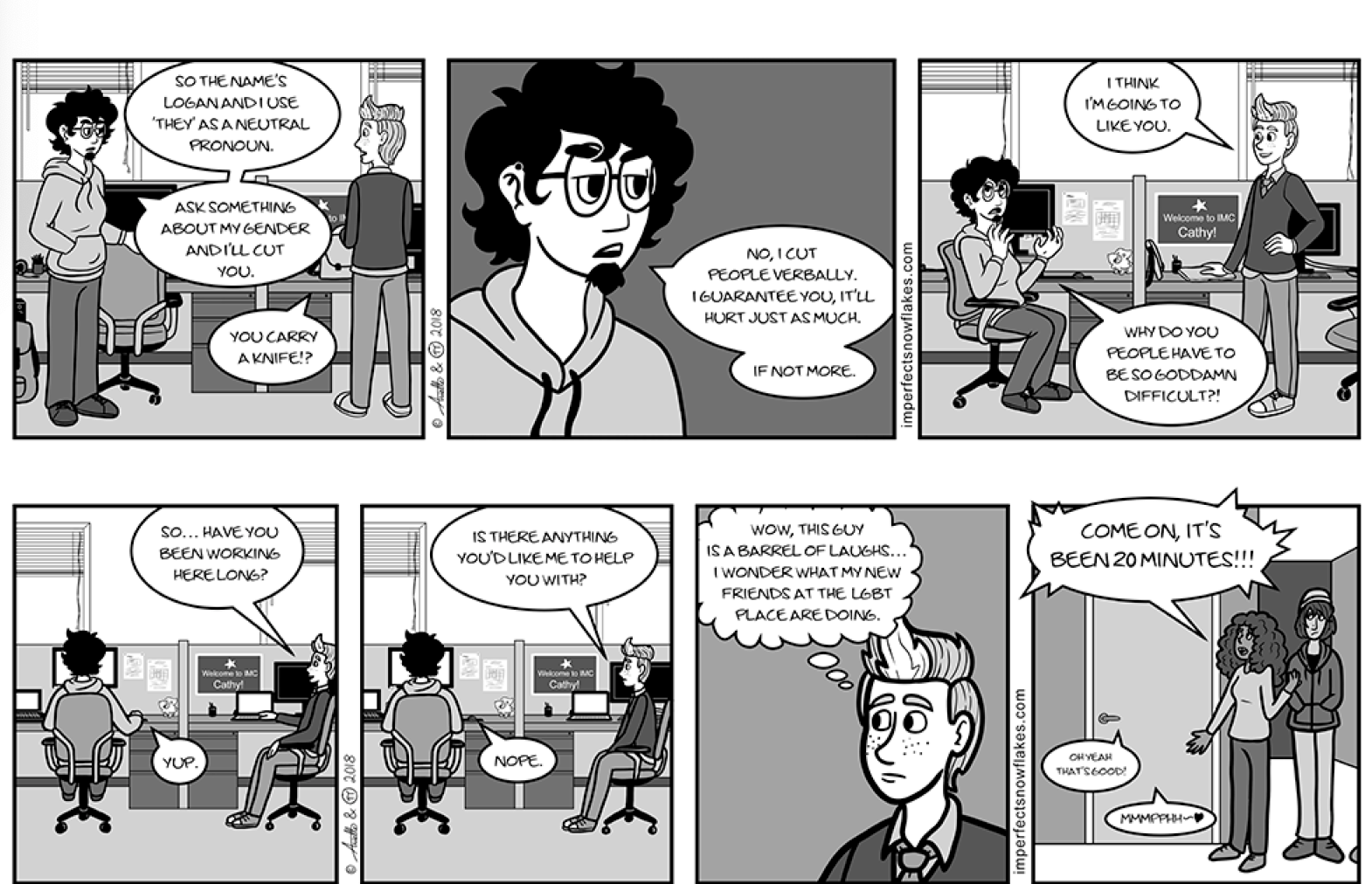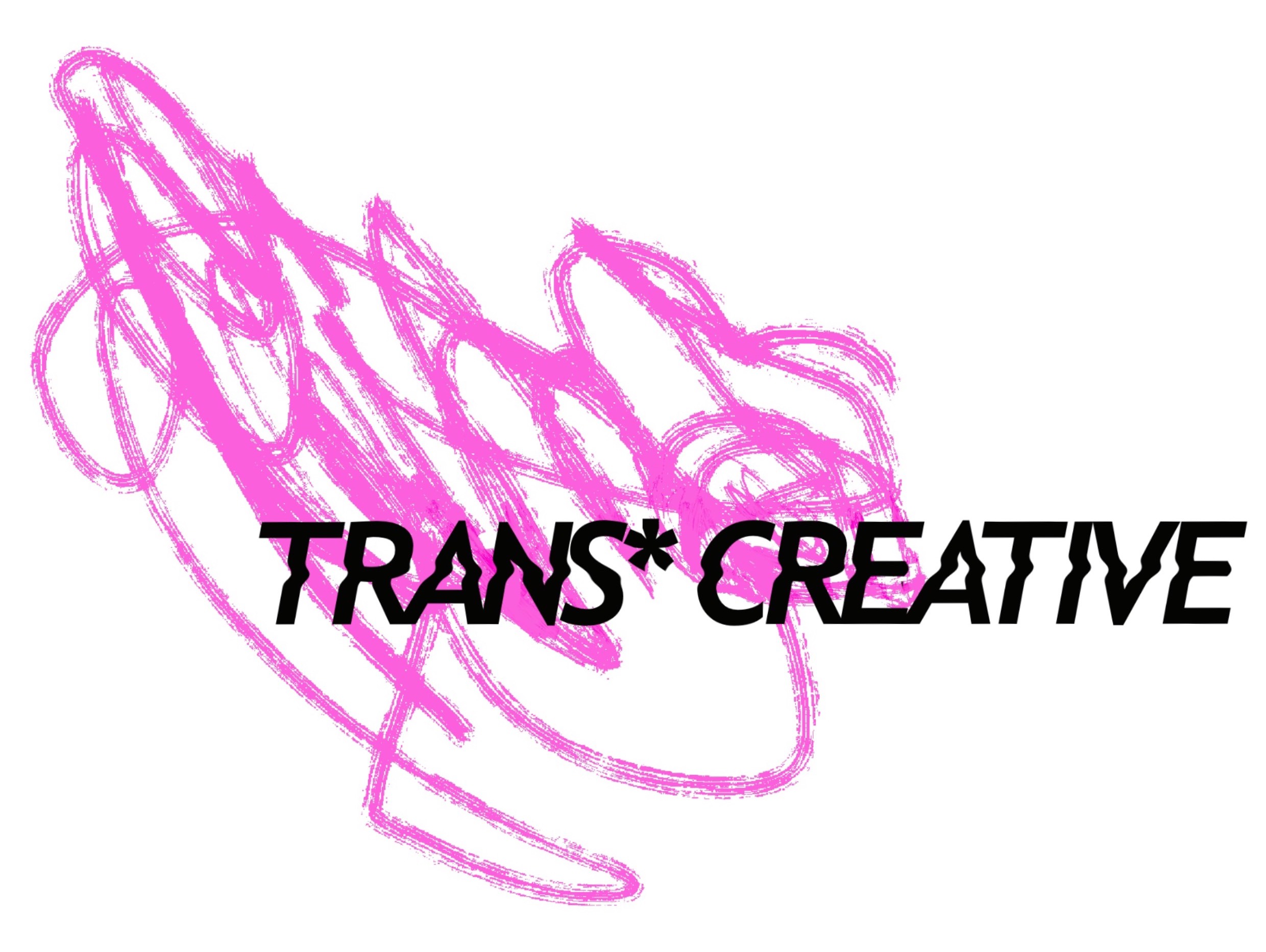
How Queer are Finnish Comics?
by: Lotta Kähkönen and Anna Vuorinne
Image from Imperfect Snowflakes created by Arielle Anttonen & Pii Anttonen
Trans*Creative was invited to collaborate with the project Diversity in Finnish Comics History: Minorities and Self-Representation (opens in a new tab) to organize a queer comics exhibition in Turku. Our team included researchers Anna Vuorinne and Lotta Kähkönen, and comic artist H-P Ontto-Panula (Lehkonen), who devised a wonderful curation plan and invited the participating comic artists. We were fortunate to secure the Main Library of Turku City Library as the venue for Defiance and Utopia: Finnish Queer Comics Across Decades (from May 3rd to May 30th, 2024). The exhibition, spanning the lobby area and the second floor, offers an exploration of the history and contemporary landscape of Finnish queer comics.
Alongside the exhibition, we hosted a panel discussion on Finnish queer comics at the Turku City Library on May 17, 2024. Anna Vuorinne moderated the discussion, featuring panelists Johanna “Roju” Rojola, Jesse Ghost, H-P Ontto-Panula, and Annukka Leppänen. We gained noteworthy insights into the history of the queer comics scene in Finland and how it has evolved in recent decades.
Finnish Queer Spirit
One of the fascinating topics was the queerness of the Finnish comics scene. H-P Ontto-Panula, who has also worked in the United States, shared that Finnish comics are particularly recognized for their queerness. At comic conventions in the US, attendees are often familiar with queer artists such as Tom of Finland and Tove Jansson, as well as contemporary artists like Max Sarin (a double Eisner Award recipient), Otava Heikkilä, Uolevi (Viima) Äikäs, Siiri Viljakka, and Sara Valta. Fans and enthusiasts frequently inquire: What is it about Finland that fosters such a prolific queer comics community? The panelists said they had no definite answer but offered various thoughts.
Ontto-Panula pondered that it can be hard to find a community as a young queer person, and drawing comics requires minimal resources—just a pen and paper. He mentions that one of the appealing aspects of comics is that you don't need to be a traditionally skilled artist. An unconventional or “ugly” drawing style can be just as compelling, as this aesthetic, and DIY spirit has a strong tradition in comics. Developing drawing skills can become a valuable social capital, allowing one to gain popularity and build networks by creating cute Pokémon illustrations or funny caricatures. Jesse Ghost added that for many young people who are uncertain about their future paths and education, comics can offer a relatively accessible and inviting approach. Annukka Leppänen exclaimed, “It’s just so cool,” emphasizing the unique ability of comics to combine writing and drawing. Comics serve as a perfect medium for self-expression and efforts to communicate with the world. For young queer people, this opportunity for self-expression may be hampered by various challenges they face. However, comics can offer a means to share their experiences and connect with others who may relate to their struggles.
While Finland boasts its talented queer artists on the international stage and Finnish comics have local specificity, it is important to acknowledge the transnational influence on Finnish queer comics and the broader comic landscape, as observed in comics studies.Footnote1 Panelists discussed drawing inspiration from international comic artists and anthologies, such as Canadian Juliet Doucet and the groundbreaking anthology Wimmen’s Comix (opens in a new tab) (first published in 1972). Sources from other countries have served as catalysts for exploring feminist and queer themes within their creations.
Studies on queer comics suggest that there might be something inherently queer about comics as a medium; it carries a certain stigma of being marginal and outcast from mainstream art. Artists in this field often maintain an awareness of their subordinate status. Additionally, comic book readers have traditionally been a niche group that includes people in marginalized positions within society, including queers.Footnote2
The important silver lining here is that the art of comics has created a space for a variety of alternative and grassroots forms of sociality among readers, creators, and content. Comics possess a “queer spirit” that involves an ongoing critique of normative social relations.Footnote3 This spirit nurtures diverse voices, allowing for the exploration and expression of identities and experiences that may otherwise be marginalized or overlooked. Through comics, individuals can engage in meaningful conversations about social justice, representation, and inclusion.
From Margin to Mainstream
If we consider the history of comics in Finland, there is indeed a relatively long history of queer presence in the comics scene. Iconic figures such as Tom of Finland represent this legacy, and there have been queer individuals involved in comic circles and the Finnish Comics Association (established in 1971) from early on, as Johanna Rojola reminds us. In the contemporary scene, at least half of the board members are queer, which, as Ontto-Panula notes, “must have an effect.” It might even be accurate to say that our queer history and queer comics have been mutually constitutive, each shaping and supporting the other.
Although the contemporary comics scene in Finland is relatively queer and provides space for queer people to be a significant part of the field, this development has not occurred without hard work and initiatives by feminist and queer artists. The panelists explained that they have actively edited or contributed to queer and feminist magazines and anthologies, which have provided opportunities for collaboration and networking.Footnote4 Through these projects, they have had the chance to get to know each other better and to build communities of queer artists in the process. What drives these activities is more or less a conscious sense of outsider status, which one seeks to overcome through creating various groups and joint efforts, analyzes Johanna Rojola. “It’s also about the desire to create communities that one has not previously had.” These efforts communicate the crucial need for creating spaces where feminist and queer artists can thrive and express themselves freely.
Nowadays, young queer people are entering the comics scene earlier, yet there is still room for improvement in addressing power structures and systemic barriers. Rojola and Ontto-Panula point out that Finland has significant room for improvement in publishing comics and enhancing their visibility in the media and cultural scene in general. This disparity becomes even more apparent when comparing the situation with Sweden, where there has been a dramatic increase in the publishing and sales of comics by women and queer artists.Footnote5 Indeed, Finland should offer more opportunities for feminist and queer creators to contribute to the vibrant cultural landscape.
Ontto-Panula notes how the situation is further reflected in the experiences of many queer comic artists who choose to work abroad due to the lack of proper opportunities and financial compensation for their work in Finland. Despite being successful and published internationally, their contributions often go unnoticed and unrecognized in Finland. He suggests that because we already have a reputation as a country of queer comics, queer comics should become an asset. Finland should proudly showcase its queer comics scene, saying, “Hey, look how queer our comics scene is!” This recognition could lead to increased visibility, support, and opportunities for queer artists both within and beyond Finland.
References
Cortsen, Rikke Platz & Ralf Kauranen 2016. “New Nordic comics—a question or promotion?" (opens in a new tab) Journal of Aesthetics & Culture, 8(1).
Halsall, Alison & Jonathan Warren 2022. “Global Crossings and Intersections.” Alison Halsall & Jonathan Warren eds., The LGBTQ+ Comics Studies Reader: Critical Openings, Future Directions. Jackson: University Press of Mississippi, 107-113.
Lindberg, Ylva 2016. “The power of laughter to change the world: Swedish female cartoonists raise their voices.” (opens in a new tab) SJoCA Scandinavian Journal of Comic Art, 2(2): 3-31.
Romu, Leena. 2022. “Smashing the Ideals of Docile Femininity: Humoristic Strategies of Feminist Resistance in Finnish Women’s Comics Magazines of the 1990s and 2000s.” European Comic Art, 15(1): 7–25.
Scott, Darieck & Ramzi Fawaz 2018. “Introduction: Queer about Comics.” American Literature, 90(2): 197–219.
Footnotes:
Cortsen & Kauranen 2016; Halsall & Warren 2022.
Scott & Fawaz 2018.
Scott & Fawaz 2018.
See also Romu 2016.
Lindberg 2016.
